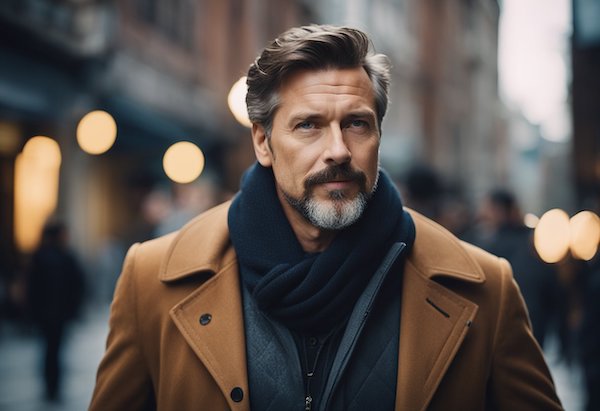
Ultimate Beard Style Guide
Beard Style Guide
Feeling ready to choose the final look and shape of your beard?
Here’s an in-depth guide to the most popular styles that your fellow Beardsmen are wearing with pride.
Pencil Stubble
Short stubble is one of the easiest and quickest styles to grow and maintain.
Results can usually be seen after just a few days, so you won’t need as much patience as the full-beard developer!
For perfect neat trimming, use a razor or an adjustable trimmer with the built-in guard pushed all the way back.
Ensure that you trim all hair growing beneath your Adam’s apple and any hair just below your cheekbone.

Medium Neat Stubble
A slightly longer variant in the Stubble style group which usually requires at least a couple of extra days of growth.
The ideal length is between 3 to 5mm long. If you let it grow any longer than this, you risk venturing into ‘Shaggy’ mode.
As with the shorter pencil stubble, ensure that you neatly trim any hair below your Adam’s apple.
Your upper cheeks should be clean shaven for a stylish finish which helps to make it clear that you’ve purposefully chosen this style and you haven’t just simply forgotten to buy new razors.
The 5 o Clock Shadow
The longest and trickiest of the Stubble variants to grow and maintain.
It gets its name from the even darkening of the bottom third of your face.
Usually measuring around 6mm, your perfect tool for neat maintenance should be the adjustable trimmer with the built-in guard set all the way back.
As ever with Stubble styles, remove any hair above the lower third of your face and below the Adam’s apple.
Use a precision trimmer or a good pair of beard scissors to get rid of any wandering stray hairs.
Classic Full Beard
Considered by many to be the definitive classic style, it’s worth noting from the start that Full Beards can be difficult to grow and not everyone is cut out to grow one.
Prepare yourself for possible mockery too, as you’re going to look a bit wild during the first month or so.
A Classic Full Beard starts at the cheek line, with everything below that line allowed to grow and fill out naturally.
(If you don’t have a very clearly defined cheek line or your line is higher than most, try drawing an imaginary line from the angle of your sideburn to the moustache outer edge.)
If your full beard is successfully starting to take form after Month 1, you can now begin work on defining your neck line and shaping your beard into the desired style.
Guidance from a professional barber or stylist may prove invaluable at this stage.

Ducktail
A spin-off style from the Full Beard which gets its name from the lower part of your beard looking similar to the tail of a duck.
The Ducktail beard is often viewed as a perfectly-struck balance between wild full beard and slickly-groomed styling.
To achieve this look, you’ll need to let the hair on your chin grow long and free whilst trimming the upper part of your beard to a much shorter length.
Circle Beard
Another popular option for Beardists who want to show off a good display of facial hair whilst still keeping a firm grip on a generally neat and well-groomed appearance.
This style combines a moustache with a rounded goatee to develop the stylish circular shape.
The good news is that it’s a relatively simple style to grow and maintain, whilst it can also help to conceal softer jaw lines and skin blemishes.
Works particularly well on the squarer face.
Goatee
Taking its name from a Billy Goats beard, the traditional Goatee is not connected to a moustache.
The hair right below your bottom lip should be allowed to grow down into the main beard growth on your chin.
The sides can then be defined as vertical or curved lines, with the general beard width matching the width of your mouth.
There are several potential variations on this style, including the Extended Goatee (or ‘The Tailback’) which adds a connected moustache to the mix.
A good tip for styling your Extended Goatee is to first grow the length longer than you need, then trim and shape the beard into your preferred style.
The Van Dyke is another twist on the Extended Goatee style, but featuring a separate unconnected moustache.
This is a generally more smooth and defined styling which may require a bit more effort with the shaping and general maintenance.
Balbo Beard
Often referred to as the ‘Robert Downey Jnr’ beard!
The Balbo consists of a moustache, and a ‘head and shoulders’ shaping beneath the bottom lip which eventually runs into a more traditional and familiar beard shaping on your chin.
It’s a particularly popular option for guys with narrow chins, and has also been known to serve well as an ‘Emergency Plan B’ for blokes who were going for the Van Dyke beard but got a bit carried away with the trimming.
Mutton Chops
The Mutton Chops are formed when you allow your bushy sideburns to grow wild and free, extending all the way down to the corners of your mouth.
Think Hugh Jackman as Wolverine or the Gallagher brothers.
The bushy sideburns should ‘stop’ at each bottom corner of the mouth, creating an imaginary defined line, with a clean-shaven moustache lip and chin completing the regular Mutton Chops look.
Friendly Mutton Chops is another twist on this theme, but includes a connected moustache.
Garibaldi
A great option for Beardsmen who fancy going a little wild but not too wild.
The seemingly full and natural beard is kept in check by a neatly-groomed moustache and a deceptively small beard length.
It’s a bold and natural look for the beard with the rounded bottom, but the beard length should actually be no more than about 20cm which is actually quite short and sensible for such a natural-looking beard.
The moustache should be neatly groomed regularly to maintain the fine balance between quiet sophistication and naturally wild chin growth.
Dutch
The Dutch Beard (or ‘The Old Dutch’) instantly conjures up images of lumberjacks who are going for the old-school look.
It’s actually along very similar beard lines to the Garibaldi, but is missing the neatly-groomed moustache and can generally be grown a little longer for a wilder, outdoors vibe.
If you can grow this beard successfully, you may very well get the urge to go camping for the weekend and chop down a few trees whilst wrestling with a bear and eating cold beans out of a tin.
Bandholz
You know you’ve hit the big time when you actually get a beard named after you.
The Bandholz beard is one of the big beard success stories in recent years.
Eric Bandholz used to work for a corporate company but was told by his employers that he was not allowed to grow a beard.
His response?
He quit his lousy job and built a successful business around his own beard!
He now runs Beardbrand, a company specialising in cool male grooming products.
The beard itself starts off life a bit like a Dutch Beard (or a Garibaldi with a connected moustache) but makes no attempt to fit in with perceived rules of neatness.
From here on in, everything is allowed to grow long, wild and, free but is maintained regularly to retain a uniquely stylish shape.
It requires a lot of effort to look this natural, so maybe not one for the complete newbie!